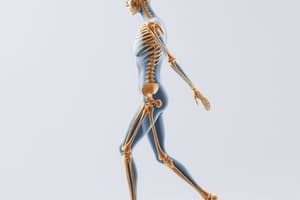Podcast
Questions and Answers
Who is considered the father of modern biomechanics?
Who is considered the father of modern biomechanics?
- Galileo
- Hippocrates
- Borelli (correct)
- Newton
Which ancient scholar is known as the father of kinesiology?
Which ancient scholar is known as the father of kinesiology?
- Hippocrates
- Galileo
- Aristotle (correct)
- Newton
Who advocated basing observations on sensory perception only?
Who advocated basing observations on sensory perception only?
- Galileo
- Hippocrates (correct)
- Borelli
- Newton
Which physicist is mentioned as one of the most prominent contributors to the field of mechanics?
Which physicist is mentioned as one of the most prominent contributors to the field of mechanics?
What is the primary concern of biomechanics as defined in the text?
What is the primary concern of biomechanics as defined in the text?
What does the term biomechanics refer to?
What does the term biomechanics refer to?
How are statics and dynamics related in the field of biomechanics?
How are statics and dynamics related in the field of biomechanics?
What does kinematics primarily focus on?
What does kinematics primarily focus on?
How do qualitative and quantitative approaches to analyzing human movement differ?
How do qualitative and quantitative approaches to analyzing human movement differ?
In what fields can the concepts of biomechanics be applied, based on the text?
In what fields can the concepts of biomechanics be applied, based on the text?
Flashcards are hidden until you start studying
Study Notes
Key Figures in Biomechanics
- Galileo Galilei is often referred to as the father of modern biomechanics.
- Aristotle is recognized as the father of kinesiology due to his early writings on human movement.
Observation and Sensory Perception
- René Descartes emphasized the importance of basing observations solely on sensory perception as a foundation for understanding motion.
Contributions to Mechanics
- Isaac Newton is highlighted as a prominent physicist whose work significantly influenced the field of mechanics, forming the basis for classical mechanics.
Definition and Focus of Biomechanics
- Biomechanics primarily concerns the study of the mechanical principles of living organisms, examining motion, forces, and the physical properties related to movement.
Understanding Biomechanics
- The term "biomechanics" refers to the intersection of biology and mechanics, focusing on movement and the forces that affect living systems.
Relationship of Statics and Dynamics
- Statics deals with forces in systems that are at rest, while dynamics involves forces in systems in motion; both are critical for understanding human motion in biomechanics.
Focus of Kinematics
- Kinematics focuses on describing the motion of bodies without regards to the forces that cause the motion, such as speed, velocity, and acceleration.
Approaches to Analyzing Human Movement
- Qualitative analysis involves subjective assessment and observation of movement, while quantitative analysis utilizes mathematical measurements and data to assess movement more objectively.
Applications of Biomechanics
- Concepts from biomechanics can be applied in diverse fields, including sports science, rehabilitation, ergonomics, and orthopedics, among others.
Studying That Suits You
Use AI to generate personalized quizzes and flashcards to suit your learning preferences.




